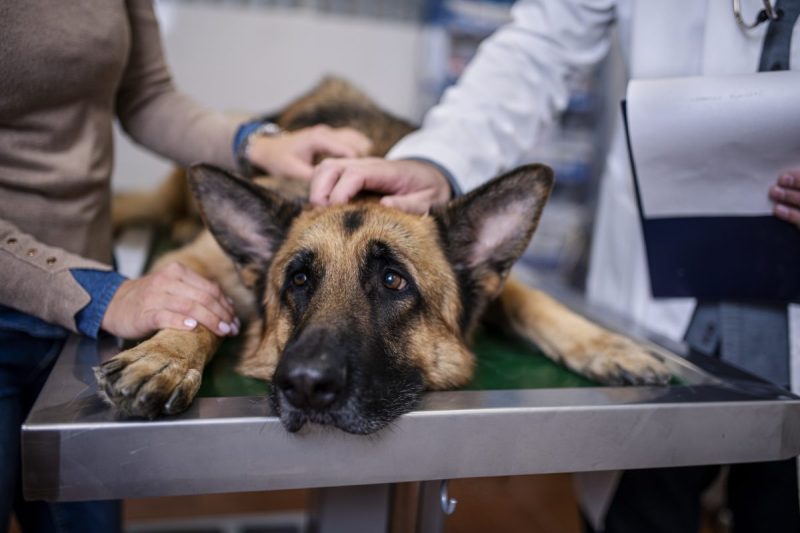VET APPROVED REVIEWED & FACT-CHECKED BY Dr. Lauren Demos (DVM) Veterinarian It’s a common myth that cats always use their litter boxes without issue.…
Bloat in dogs is a life-threatening condition where the stomach fills with gas and, in some cases, rotates, which puts pressure on other organs and traps blood in the stomach.
This prevents blood from returning to the heart and circulating throughout the body, and the buildup of gas can cause breathing difficulty, damage the spleen, or cause the stomach to rupture. If it goes untreated, the condition can cause dogs to go into shock or die within hours.
Bloat usually appears quickly in dogs and requires immediate emergency medical attention. The cause of bloating and twisting of the stomach, also known as gastric dilation and volvulus (GDV), isn’t fully understood. It’s also unclear whether the bloating or the twisting happens first.
If you see the signs of bloat in your dog, get to an emergency veterinarian immediately for treatment, as the condition is very deadly when left untreated.
Here’s what you should know about the symptoms, causes, and treatments for bloat in dogs.
Symptoms Of Bloat In Dogs
The symptoms of bloat in dogs come on quickly and severely. As the pulse gets quicker and weaker, shock or death can occur in as little as an hour.
This is why it’s so important to see an emergency veterinarian as soon as you notice any of the signs of bloat in your dog, even if it’s just one or two symptoms.
Here are some common symptoms of bloat:
- Dry heaving (attempting to vomit without producing vomit)
- Restlessness or pacing
- Difficulty moving
- Drooling
- Panting
- Difficulty breathing
- Extreme abdominal distension (bloating)
- Pain in the abdomen (whimpering, crying, wincing when touched)
- Pale gums
- Fast, weakening heartbeat
- Weakness
- Collapse
Causes Of Bloat In Dogs
The causes of bloat in dogs are not clear, and veterinarians don’t know if gas builds up in the stomach and causes it to twist, or if the stomach twists and causes gas to build up.
One theory is that when large dogs eat a lot of food quickly, ingest air, drink a lot of water, and then exercise, the stomach starts swinging and eventually twists around itself. However, some dogs who suffer from bloat do not have a full stomach, so that theory may not hold up.
Another theory is that — as stomach contractions weaken with age — food and air stay in the stomach for longer, which causes the stomach to grow heavy and twist.
Yet another theory says that the spleen can cause the stomach to become heavy and twist.
Regardless of the actual cause, there are some factors that put dogs more at risk for developing bloat. Eating large meals quickly, overeating, exercising after eating, stress, and having genetic relatives who suffer from bloat all make the condition more likely to appear in dogs.
Certain breeds are more predisposed to the condition, including:
- Akitas
- Basset Hounds
- Boxers
- Doberman Pinschers
- German Shepherds
- Great Danes
- Irish Setters
- Saint Bernards
- Standard Poodles
- Weimaraners
Male dogs are twice as likely to develop bloat as females.
Treatments For Bloat In Dogs
Treatment for bloat in dogs sometimes depends on how severe the condition is. The veterinarian may begin by putting a tube down an affected dog’s throat to release gas and decrease pressure.
If the twisting of the stomach prevents the tube from passing through, a hollow needle may be inserted through the abdomen instead.
Dogs suffering from bloat are often treated for shock with intravenous fluids, and possibly with medication. Once an affected dog is stable and the stomach is decompressed, the vet will begin emergency surgery to untwist the stomach and make sure it goes back into its normal position.
The vet may need to surgically remove damaged tissue, as well.
Relapse is common in dogs who suffer from bloat. Therefore, vets usually tack the stomach to the abdominal wall in order to stop it from twisting again.
If your dog is recovering from bloat, follow your vet’s instructions for follow up care, dietary or lifestyle changes, and at-home treatment closely.
Has your dog ever suffered from bloat? Was your vet able to treat your dog? Let us know in the comments below.

